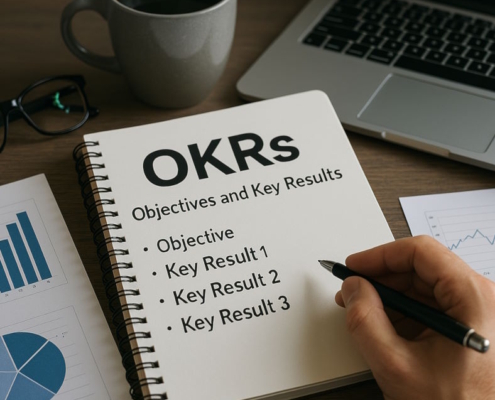Step 1 – How to Choose a Good Business Idea
The first step to creating a startup company is to come up with a unique, and hopefully profitable, idea for a business. In this beginning stage, an entrepreneur should think about his or her own interests, skills, availability, resources, and the reasons why he or she is interested in forming a new business. For example, if an individual has special skills in woodworking, then perhaps he or she would want to start a carpentry business. Or if a person has a passion for robotics, then he or she may wish to enter into that industry. Maybe an individual simply prefers working for themselves, and not in an office for somebody else. In this instance, they may wish to start their company and control their own success and future. Another part of the idea stage involves considering the chance of success based on what one’s community needs. For instance, if a community has no French bistros, yet there is a community desire for croissants and coffee, then the business idea will meet a need. However, if the community already has five bistros, then the idea will not fulfill a need because it has already been met.
After choosing a promising idea, an entrepreneur should think about creating a business plan to assess the likelihood of making a profit. When an entrepreneur creates his or her plan, he or she will have a better understanding of the startup costs, the potential competition, and strategies for marketing and making a profit. A business plan is an important step of brainstorming because potential investors and lenders will want to review it before agreeing to offer financial assistance. Before pledging money to the project, they will want to know there is a solid plan in place to achieve success, Therefore, creating a business plan is critical at this stage in order to solicit funding, if thereafter necessary.
Example: For the past ten years, Leo has been working a day-to-day office job that he finds uninspiring. He has recently decided to quit to start his own business. While he loves the idea of working for himself, Leo is not sure what kind of business to start. One weekend, while camping with his best friend, Gerard, Leo asks his friend about ideas for a company. Gerard suggests thinking about favorite hobbies, things that Leo feels passionate about and would want to work on every day. Leo looks around. Camping, of course! Leo decides to start a company that sells camping and outdoors equipment. This is a subject that Leo knows a lot about and has a passion for. Not only that, but Leo lives in Los Angeles, where many people go hiking and camping on the weekends in local mountains and forests. He therefore knows that there is a community need and desire for his potential products. With this idea in mind, Leo sets about making a business plan to attract investors.
Step 2 – How to Decide on the Correct Legal Structure for a Business
When an entrepreneur has come up with a great idea for a new business, his or her next step will be to decide on a legal structure for the company. There are several types of legal entity structures for new businesses to choose from, each with their own advantages and disadvantages. A new business owner will have to analyze each type to determine which best suits the company’s interests. The most common kinds of legal entities include the following:
- Sole proprietorship
- Partnership
- Limited liability company (LLC)
- Corporation
In addition, there are special varieties of these structures, such as limited partnerships and S corporations. An entrepreneur will need to think about which business entity structure offers the amount of liability protection he or she would like. Also to be considered are the tax structure, financing, and financial benefits that come with certain entity types. For instance, a limited liability company offer liability protection, unlike a sole proprietorship. So, if a business owner is taken to court in a lawsuit, without liability protection, he or she could lose their assets in a judgment. Assets could include cars, homes, or personal savings, the loss of any of which could severely impact one’s life. Certain corporation types offer significant tax advantages which, depending on the business, could be a major advantage. And for those who have a simple business in mind and would like to avoid a lot of paperwork and costs, a sole proprietorship offers its own advantages.
Example: Sam is in the process of starting his own company, a coffee shop selling unique blends from around the world, as well as herbal teas. Because Sam in new to the business world, he is not sure what kind of entity type to choose for his business. Because he is starting small with very few employees, Sam decides to become a sole proprietorship. It seems to be the easiest option, and Sam hates the bureaucracy involved with legal paperwork and registration. However, a year down the line, Sam runs into a problem. A barista accidentally knocked dish soap into a cup of coffee, sickening a customer. The customer sues Sam’s business. Because Sam’s coffee shop is a sole proprietorship, Sam is responsible in the event of any legal action. The customer wins the lawsuit, and Sam ends up losing his car and personal savings to pay for damages. Having learned a harsh lesson, when he recovers, Sam decides to turn his business into a limited liability company. As an LLC, Sam receives liability protection. This way, if the company is ever sued again, Sam will not lose any of his personal assets. Happily, Sam’s coffee shop really begins to take off, gaining a lot of traction in the local community. As a result of this popularity and the legitimacy of the company’s entity type, Sam’s business gets the attention of investors, who want to help him expand the business.
Step 3 – How to Choose the Right Business Name
If an entrepreneur is establishing an LLC or a corporation, he or she will need to check that the business’ name is unique from the names of all other business entities already filed with the California Secretary of State (SOS). It is possible to check for available names by conducting a business entity name search on the SOS website. If an entrepreneur has a unique name in mind, and it is not already taken, he or she may reserve the name for 60 days. He or she may do so by filing a Name Reservation Request Form. One should know that there are specific name requirements for limited liability companies and corporations. For instance, the acronym ‘LLC’ should be used for limited liability companies and the acronym “Corp” or “Co” for corporations.
Businesses that are sole proprietorships or partnerships will have a business name that is technically the legal name of the entrepreneur who owns it. Therefore, if the business owner wishes to operate under a different name, he or she will need to file a Fictitious Business Name Statement with the county clerk’s office for the county in which the business is located.
If a business plans on doing online business, then an entrepreneur may wish to register the business’ name as a domain name so that no one else takes it. In order to avoid trademark violations, one should conduct a federal and state trademark check to ensure that the desired name is not already in use or is too similar to another name.
Example: As an artist, Joanna is starting her own tattoo and piercing parlor in Los Angeles. She has been thinking about the perfect name for her business and has settled on “The Pen and Rose.” However, when she searches the name in the California Secretary of State’s database, she finds that it has already been taken by another business. Forced to think of another name that is unique, Joanna chooses “The Poison Lily,” which she is happy to discover has not already been claimed by anyone else. Because Joanna has made her business a limited liability company so that she has liability protection, she has to make her official company name “The Poison Lily LLC” to comply with state naming regulations.
Step 4 – How to Register a Business Entity
Sole Proprietorship
To create a sole proprietorship in California, an entrepreneur does not need to file any organizational paperwork with the state.
Partnership
To create a general partnership in California, an entrepreneur does not need to file any organizational paperwork with the state, While it is not required legally, every partnership should have a partnership agreement in writing. A partnership agreement can be useful in the event there is ever a dispute between the partners. To create a limited liability partnership, which is often used by professionals, an entrepreneur must file a Registration with the California Secretary of State.
Limited Liability Company
To form an LLC in California, an entrepreneur must file Articles of Organization with the California Secretary of State. One will also need to appoint either a personal agent or a corporate agent for service of process in California. In other states, this function is known as registered agent. Also, even though it is not legally required, an entrepreneur should create an operating agreement which will establish the essential rules regarding how the LLC will operate. This operating agreement is not filed with the state.
Corporation
To form a corporation in California, an entrepreneur must file Articles of Incorporation with the California Secretary of State. One will also need to appoint either a personal agent or a corporate agent for service of process in California. In other states, this function is known as registered agent. While it is not required by law, an entrepreneur should also prepare bylaws that will establish the corporation’s internal operating regulations. Bylaws are not filed with the state. S corporations also need to file IRS Form 2553, or Election by a Small Business Corporation, with the IRS.
Example: Henry is starting a seafood restaurant based in Los Angeles. He is currently considering what type of business entity to register his company as. Because Henry is preparing and serving seafood, he is concerned about the possibility of a customer getting food poisoning. While Henry is careful about providing safe and healthy food, accidents can happen. He does not want to be involved in a major lawsuit that could threaten the loss of his personal assets. Therefore, he thinks it is best that his business be a limited liability company. This way, if someone gets sick and sues the restaurant, Henry will not lose his car, home, or personal savings in a judgment.
Step 5 – How to Apply for California Licenses and Permits
Tax Registration
If an entrepreneur will be selling products in the state of California, then he or she will need to register with the Board of Equalization (BOE) in order to get a seller’s permit. One may register online at the BOE website. If the business will hire employees, then the entrepreneur must register with the California Employment Development Department (EDD) for employer withholding taxes. One may register online via the EDD’s Employer Services Online.
EIN
If a business has employees or is taxed separately from its owner, then the owner must get a federal Employer Identification Number, or EIN, from the Internal Revenue Service (IRS). Even if one is not required to get an EIN, from a business point of view there are many reasons to do so. Banks often ask for an EIN in order to open an account in the business’ name. Also, other companies with whom an entrepreneur does business may require an EIN in order to process payments. A business owner may get an EIN by completing an online application on the IRS website. Luckily, there is no fee to file.
General Business License
Every business in California must get a general business license from the city where the business is located. If a business is located in unincorporated areas of the state, then the license is issued by the county in which the business is located.
Regulatory Licenses and Permits
These licenses and permits address issues such as health and safety, building and construction, the environment, and specific services and industries. Regulatory licenses and permits are often given out by state agencies. The CalGold website offers step-by-step help regarding what state licenses and permits a business owner may need. To get information about local regulatory permits and licenses, one may check city and county websites.
Professional and Occupational Licenses
These types of licenses concern people who work in certain fields. One may refer to California’s CalGold website for information on professional and occupational licensing.
Example: Katy is opening a brand-new bar in Los Angeles where she will sell specialty cocktails featuring her own gin. However, before she can begin serving customers, Katy must be sure to secure a liquor license. This way, she can legally serve alcohol to the public.
Step 6 – How to Choose a Business Location and Check Zoning Regulations
A new business owner will need to choose a location for his or her business and check the local zoning regulations. It is important that the owner consider the needs of his or her customers and whether their manner of business would benefit from being close to a highway or a walkable shopping center, for example. Before committing to a location, an owner should take the time to add up costs of operating the business in that specific spot. These costs should include rent and utilities. He or she should then refer to their business plan to assess whether that location is affordable, especially during the company’s early months.
It is crucial to see whether the desired spot is zoned for one’s type of business. It is possible to find zoning regulations in a town or city by checking local ordinances or contacting the local zoning or planning department.
Instead of opening a business at a new location, one may always choose to run their company out of the comfort of their own home. If an entrepreneur chooses to go down this path, then he or she should be sure to check local zoning laws. It will also be important to review the terms of one’s lease, if renting, or homeowner’s association regulations. Either of these authorities may restrict or outright ban home businesses.
Example: Isaiah is starting his own VR, or virtual reality gaming business. At his shop, customers can don VR headsets and play simulation games in a group setting, similar to laser tag. Initially, Isaiah thought it would be a good idea to locate his business near a highway, since this would make it conveniently located for many surrounding areas. However, he has recently seen real estate open up at a local outdoor shopping mall. There, he could attract the hordes of young adults and teenagers who spend weekends hanging around the shops, as well as families looking for things to do. This seems to be a better location for his business, because it targets the precise demographic he is hoping to attract.
Step 7 – How to Register and Report a Business’ Taxes
In California, every kind of business is taxed. This standard includes a corporate income tax that applies to corporations and other entities that are taxed in the manner of corporations. There is also a franchise tax that applies to corporations, limited liability companies, as well as some partnerships.
Sole Proprietorships
As part of their personal state income tax returns, sole proprietorships pay state taxes on business income.
Partnerships
Partners pay state taxes on partnership income on their personal tax returns. Also, partnerships in the state of California must file Form 565, which is the Partnership Return of Income form.
Limited Liability Companies
Members of limited liability companies must pay state taxes on their share of LLC income on their personal tax returns. Also, LLCs must file an extra state tax form. The particular form will depend on how the company is classified when it comes to federal taxes. LLCs in California must also file a statement of information every other year.
Corporations
Shareholders are required to pay state taxes on the dividends they receive from the corporation. A shareholder-employee that takes a salary also must pay state income tax on his or her personal state tax return. Also, the corporation must pay California corporation taxes, as well as filing an annual statement of information with the California Secretary of State.
If a business has employees, then the employer must also be responsible for state employer taxes.
Beyond the issue of taxes, an employer must manage federal income and employer taxes. To review these, one should look at IRS Publication 334 (Tax Guide for Small Businesses) and Publication 583 (Taxpayers Starting a Business).
Step 8 – How to Get Business Insurance
It is wise to obtain insurance for one’s business in order to protect both the company and personal assets in the event of unexpected crises, such as natural disasters and personal injury lawsuits. An insurance agent can help an employer review the different types of coverage options and choose the best one for his or her business. These options may include general liability insurance to protect against claims regarding bodily injury and property damage. Other options may include cyber liability, which covers lawsuit and settlement fees after a data security breach.
Step 9 – How to Open a Business Bank Account
Regardless of what kind of business an entrepreneur starts, he or she should strongly consider opening a business bank account to track expenses as well as income. For certain business types, such as LLCs and corporations, it is necessary to have a separate bank account for the business in order to maintain liability protection.































